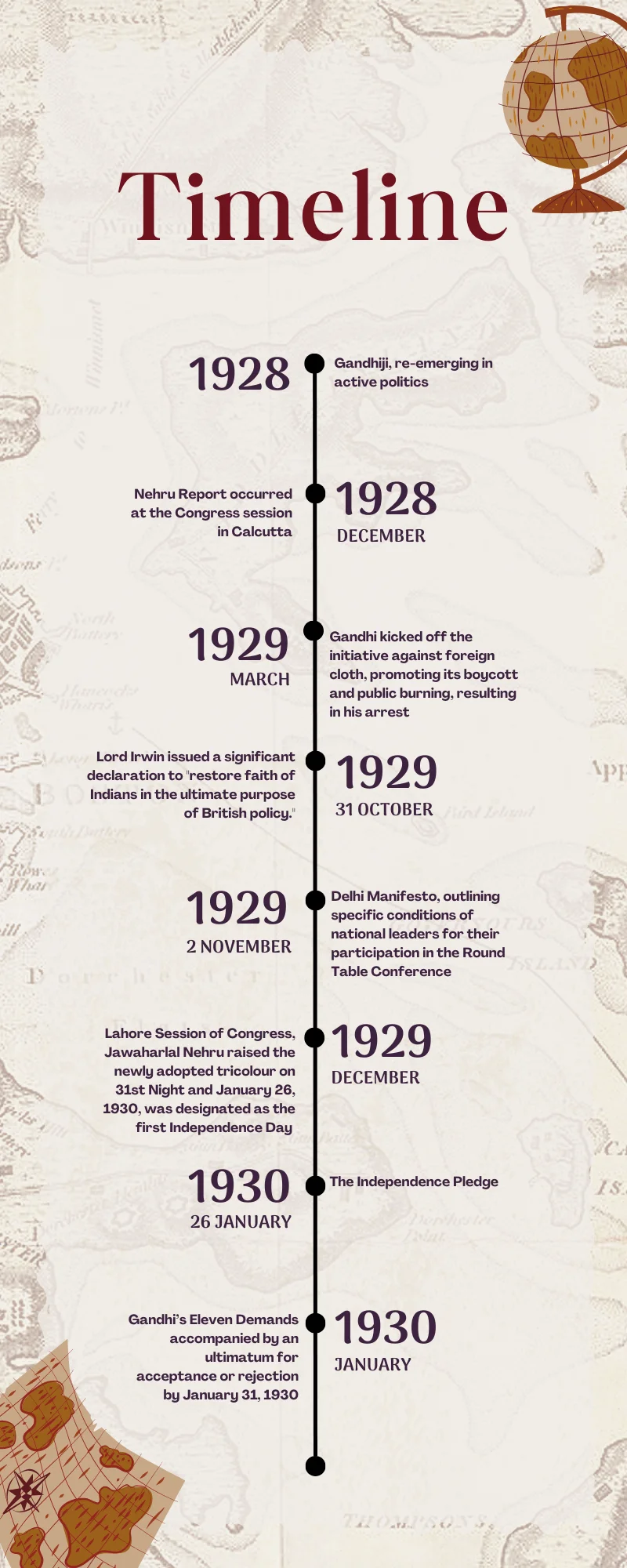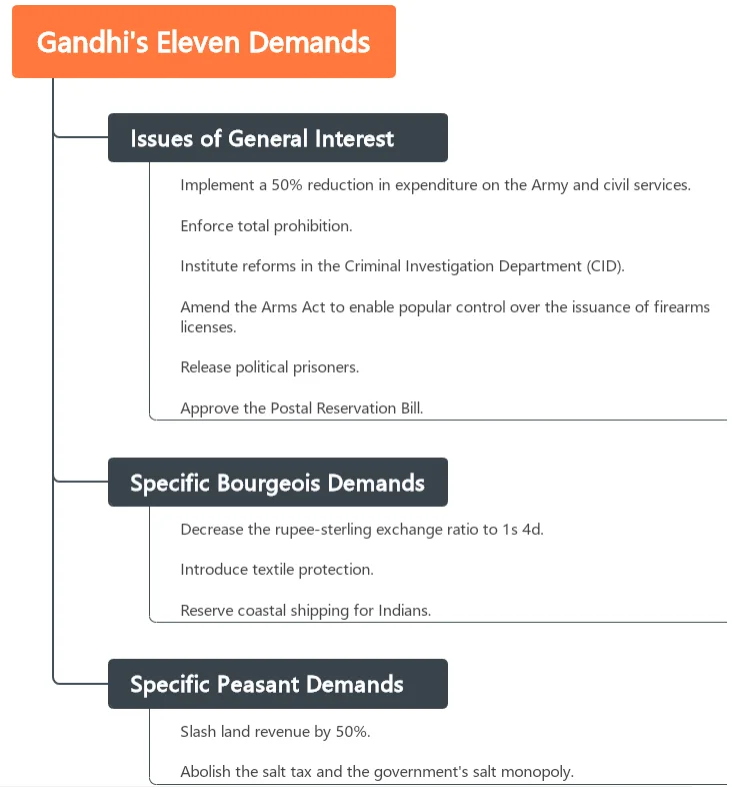Gandhiji, re-emerging in active politics in 1928, issued the call for a Civil Disobedience Movement (CDM) in 1930. Distinguished from the preceding Non-Cooperation Movement (1921-22), the CDM aimed to disrupt the administration by deliberately committing specific illegal acts, in contrast to the NCM’s strategy of non-cooperation with the government. Personally initiating the CDM, Gandhi broke the oppressive Salt Laws on March 12, 1930, leading 78 followers on the historic Salt March from Sabarmati Ashram to Dandi Beach to illicitly produce salt. Subhash Chandra Bose compared the Salt March to Napoleon’s return from Elba. English journalist Mr. Brailsford dismissed the Dandi March as a “kindergarten stage of revolution,” The Statesman of Calcutta sarcastically suggested that Gandhi might not find boiling seawater until Dominion Status was achieved.
The Run-up to Civil Disobedience Movement
Calcutta Session of Congress in 1928
- Push for Complete Independence over Dominion Status: The approval of the Nehru Report occurred at the Congress session in Calcutta in December 1928.
- However, discontent surfaced among younger leaders, notably Jawaharlal Nehru, Subhash Bose, and Satyamurthy, who opposed the adoption of dominion status as the Congress’s goal.
- They advocated for Purna Swaraj, complete independence, instead.
- Call for Patience and Consensus: In contrast, senior figures like Gandhi and Motilal Nehru urged caution, emphasizing the consensus achieved over dominion status through years of efforts.
- Initially proposing a two-year grace period for the government to accept the dominion status demand, they yielded to pressure from the younger faction, reducing it to one year.
- Congress’s Ultimatum: The Congress resolved that if the government didn’t accept a constitution based on dominion status by year-end, they would demand complete independence and launch a civil disobedience movement to achieve this objective.
Enroll now for UPSC Online Course
Political Activity during 1929
- Mobilization and Preparation for Political Action: Throughout 1929, Gandhi engaged in extensive travel, preparing the public for imminent political action.
- His efforts involved encouraging youth to brace themselves for challenges, organizing constructive work in villages, and addressing specific grievances, drawing inspiration from the successful Bardoli agitation of 1928.
- The Congress Working Committee (CWC) established a Foreign Cloth Boycott Committee to advocate an assertive campaign against foreign cloth, promoting its boycott and public burning.
- Gandhi kicked off the initiative in March 1929 in Calcutta, resulting in his arrest, followed by widespread bonfires of foreign cloth across the nation.
- Political Developments and Revolutionary Activities: The political climate remained charged in 1929 with notable events such as the Meerut Conspiracy Case( started in March 1929 and decided in 1933).
- The bomb explosion in the Central Legislative Assembly (April 8, 1929) by Bhagat Singh and B.K. Dutt, and the formation of the minority Labour government, led by Ramsay MacDonald, in England in May 1929, with Wedgewood Benn appointed as the Secretary of State for India.

Irwin’s Declaration
- Lord Irwin’s Declaration: Before the release of the Simon Commission report, Lord Irwin issued a significant declaration (October 31, 1929), marking a joint effort of the Labour government, more inclined towards Indian aspirations, and a Conservative viceroy.
- The objective behind this declaration was to “restore faith in the ultimate purpose of British policy.”
- On October 31, 1929, the official communique was published in the Indian Gazette, clarifying the British government’s stance.
- Unfulfilled Promise of Dominion Status: It emphasized that the natural outcome of India’s constitutional progress, as envisioned in the Declaration of 1917, was the attainment of Dominion status.
- However, no specific timeline was provided, indicating that Dominion’s status, as promised by Irwin, would not be promptly realized.
- The promise of a Round Table Conference: The declaration, while noteworthy, lacked revolutionary elements.
- Lord Irwin also committed to convening a Round Table Conference following the submission of the Simon Commission’s report.
Delhi Manifesto
On November 2, 1929, a conference featuring prominent national leaders issued the ‘Delhi Manifesto,’ outlining specific conditions for their participation in the Round Table Conference:
- Objective of The Round Table Conference: The Round Table Conference’s objective should be to formulate a constitution for implementing dominion status, acting as a constituent assembly.
- The basic principle of dominion status should be immediately accepted.
- Lord Irwin Assurance: Assurance given by Lord Irwin about Congress’s and all other Political Party’s demands would be considered at the coming Round Table Conference.
- Representation of Political Parties: The Congress should have majority representation at the conference.
- Leaders demanded representation of all political parties and groups at round table conferences to ensure comprehensive and inclusive decision-making in the governance of India.
- Policy for Political Prisoners: There should be a general amnesty for political prisoners and a policy of conciliation.
- Proposal for Dominion Status: In December 1929, Gandhi, along with Motilal Nehru and other political leaders, met with Lord Irwin. They sought assurance from the viceroy that the round table conference’s purpose was to draft a constitutional scheme for dominion status.
- However, on Dec 23rd, 1929 Irwin stated that this wasn’t the conference’s purpose, rejecting the demands outlined in the Delhi Manifesto.
- This marked the beginning of a stage set for confrontation.
- However, on Dec 23rd, 1929 Irwin stated that this wasn’t the conference’s purpose, rejecting the demands outlined in the Delhi Manifesto.
Lahore Congress and Purna Swaraj
Jawaharlal Nehru got the presidency of the Lahore session of the Congress in December 1929 with Gandhi’s backing (despite opposition from 15 out of 18 Provincial Congress Committees).
- His nomination was fitting given the Congress’s adoption of complete independence as its goal and to acknowledge the youth-led success of the anti-Simon campaign.
Emphasizing peaceful mass movements, Nehru outlined the following decisions from the Lahore session:
- The Round Table Conference was to be boycotted.
- Complete independence was declared as the Congress’s aim.
- The Congress Working Committee was authorized to launch a civil disobedience program, including non-payment of taxes, and members of legislatures were urged to resign.
- January 26, 1930, was designated as the first Independence Day, to be celebrated nationwide.
On December 31, 1929, at midnight on the banks of the River Ravi, Jawaharlal Nehru raised the newly adopted tricolour flag of freedom amidst chants of “Inquilab Zindabad.”
The Independence Pledge (January 26, 1930)
Nationwide public meetings were orchestrated in villages and towns, where the pledge of independence was recited in local languages and the national flag ceremoniously raised. This pledge, attributed to Gandhi, encapsulated the following principles:
- Indians possess an inherent right to freedom.
- Impact of British Government: The British Government in India has not only deprived and exploited the nation but also inflicted economic, political, cultural, and spiritual ruin.
- Hence, India must sever ties with Britain and achieve complete independence (Purna Swaraj).

- Economic deterioration: It is fueled by exorbitant revenue demands, the obliteration of village industries without viable substitutes, and manipulations in customs, currency, and exchange rates to India’s detriment.
- The absence of genuine political powers, denial of free association rights, and suppression of administrative talent are lamented.
- Culturally, the education system has severed connections to cultural roots.
- Spiritually, compulsory disarmament has emasculated the nation.
- Resisting British rule is deemed a crime against humanity and divinity.
- Preparation for complete independence involves disengagement from voluntary associations with the British government and readiness for civil disobedience, including non-payment of taxes, ensuring the end of this oppressive rule.
- Adherence to Congress instructions is committed to establishing purna swaraj.
Enroll now for UPSC Online Course
| Must Read | |
| Current Affairs | Editorial Analysis |
| Upsc Notes | Upsc Blogs |
| NCERT Notes | Free Main Answer Writing |
Conclusion
The events that caused the Civil Disobedience Movement were crucial in India’s fight for freedom. Gandhi’s calculated return to involvement in politics, exemplified by the famous Salt March, demonstrated resistance to British rule and set the stage for widespread civil disobedience. The Lahore Congress, under Nehru’s leadership, brought the nation together in the pursuit of complete independence, marking the beginning of a determined struggle for freedom with Purna Swaraj as the ultimate objective.
Sign up for the PWOnlyIAS Online Course by Physics Wallah and start your journey to IAS success today!
| Related Articles | |
| Civil Disobedience Movement | Pandit Jawaharlal Nehru |
| Simon Commission 1927 | British Policy in India |

 GS Foundation
GS Foundation Optional Course
Optional Course Combo Courses
Combo Courses Degree Program
Degree Program











